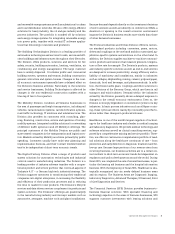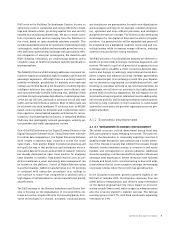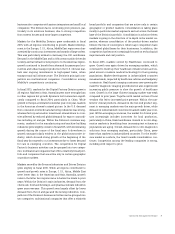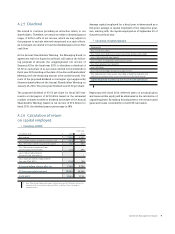Siemens 2015 Annual Report Download - page 9
Download and view the complete annual report
Please find page 9 of the 2015 Siemens annual report below. You can navigate through the pages in the report by either clicking on the pages listed below, or by using the keyword search tool below to find specific information within the annual report.Combined Management Report
business also competes with system integrators and small local
companies. The Division faces continuing price pressure, par
-
ticularly in its solutions business, due to strong competition
from system houses and some larger competitors.
Markets for the Mobility Division grew moderately in fiscal
, with all regions contributing to growth. Market develop-
ment in the Europe, C. I. S., Africa, Middle East region was char-
acterized by continuous investment and awards of large orders.
This was particularly evident in Germany, the U. K. and Russia.
Demand in the Middle East and in Africa was mainly driven by
turnkey and rail infrastructure projects. In the Americas region,
growth continued to benefit from demand for passenger loco-
motives and urban transport products in the U. S. Chinese mar-
kets saw ongoing investments in high-speed trains, urban
transport and rail infrastructure. The Division’s principal com-
petitors are multinational companies. Consolidation among
Mobility’s competitors is continuing.
In fiscal , markets for the Digital Factory Division grew in
all regions. Markets in Asia, Australia grew more strongly than
in other regions but growth dynamics lost momentum signifi-
cantly compared to fiscal , particularly in China. While
growth in Europe accelerated somewhat year-over-year, markets
in the Americas showed a mixed picture: In the U. S. demand
from consumer-oriented manufacturing industries was strong,
whereas factory automation investment slowed down in coun-
tries affected by reduced global demand for export commodi-
ties including oil and gas. Within the Division’s customer seg-
ments, markets for the manufacturing and machine building
industries grew slightly overall in fiscal , with decelerating
growth during the course of the fiscal year. A slow-down in
growth was particularly evident in the global automotive in-
dustry, which showed strong growth at the beginning of the
fiscal year but started to cut investments due to lower demand
for cars in emerging countries. The competition for Digital
Factory’s business activities can be grouped into two catego-
ries: multinational companies that offer a relatively broad port-
folio and companies that are active only in certain geographic
or product markets.
Markets served by the Process Industries and Drives Division
grew slightly in fiscal . While all regions contributed to
growth and growth rates in Europe, C. I. S., Africa, Middle East
were lower than in the Americas and Asia, Australia, growth
rates in the latter two regions came in below the levels in prior
years. Within the Division’s main industries, demand from the
chemicals, food and beverage, and pharmaceuticals industries
grew year-over-year. This growth was largely offset by lower
demand from the oil and gas and the mining industries. Com-
petitors of the Division’s business activities can be grouped into
two categories: multinational companies that offer a relatively
broad portfolio and companies that are active only in certain
geographic or product markets. Consolidation is taking place
mostly in particular market segments and not across the broad
base of the Division’s portfolio. Consolidation in solution-driven
markets is going in the direction of in-depth niche market ex-
pertise, whereas consolidation of the product-driven market
follows the line of convergence. Most major competitors have
established global bases for their businesses. In addition, the
competition has become increasingly focused on technological
improvements and cost position.
In fiscal , markets served by Healthcare continued to
grow. Growth was again driven by emerging markets, which
continued to build up their healthcare infrastructures and ex-
pand access to modern medical technology for their growing
populations. Market development in industrialized countries
remained weak, impacted by healthcare reforms and budgetary
constraints. Healthcare’s imaging customers saw growing de
-
mand for diagnostic imaging procedures but also experienced
increasing public pressure to slow the growth of healthcare
costs. Growth in the large Chinese imaging market was weak
compared to prior years. Together with market entries of local
vendors this led to increased price pressure. Within the mar-
kets for clinical products, demand in the low-end product seg-
ment in emerging markets was the main growth driver, while
demand in industrialized countries remained stable year-over-
year. Within emerging economies, the market for clinical prod-
ucts increasingly includes incentives for local production,
particularly in China, Brazil and Russia. Growth in in-vitro diag-
nostics markets is benefiting from increasing test volumes as
populations are aging. Overall, demand for in-vitro diagnostics
solutions from emerging markets, particularly China, grew
faster than markets in industrialized countries. For the health-
care market as a whole, the trend towards consolidation con-
tinues. Competition among the leading companies is strong,
including with respect to price.






















